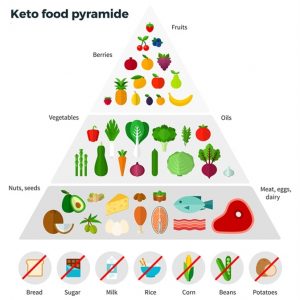When it comes to following the popular Keto diet, there’s something important to keep in mind: the risk of Ketoacidosis. To help in understanding this complex subject, here is a primer on the potential dangers of Ketoacidosis and what to do if it occurs.
Table of Contents
- 1. What is Ketoacidosis and Why is it Dangerous?
- 2. What Causes Ketoacidosis?
- 3. Who is at Risk for Developing Ketoacidosis?
- 4. What are the Symptoms of Ketoacidosis?
- 5. Preventing Ketoacidosis: How to Reduce Your Risk.
- Q&A
1. What is Ketoacidosis and Why is it Dangerous?
Ketoacidosis is a dangerous medical condition that occurs when the body’s blood sugar level becomes too high. The body’s response to high blood sugar is to break down fat, resulting in an accumulation of ketone acids in the bloodstream. In turn, this can lead to health risks like vomiting, nausea, fatigue, and confusion.
Ketoacidosis can be a side effect of a medical condition, such as diabetes, or even starvation. It can also be caused by conditions that cause the body to become too acidic. Some medications, including chemotherapy drugs and certain steroids, can also lead to ketoacidosis.
In those at risk for developing the condition, early diagnosis is key to proper treatment. Symptoms include:
- Fatigue
- Frequent urination
- Headache
- Nausea and vomiting
- High blood sugar
If left untreated, ketoacidosis can have serious, long-term effects on your body. It can cause dangerous changes in the fluid balance in your organs, lead to severe dehydration, and even cause shock. In more severe cases, it can lead to coma or death.
2. What Causes Ketoacidosis?
Ketoacidosis is a potentially life-threatening condition which is a result of a build-up of ketones in the body. This can occur when the body doesn’t have enough insulin or when the body isn’t able to use the insulin it produces. There are two main types of ketoacidosis – type 1 and type 2.
Type 1 ketoacidosis is primarily seen in people with type 1 diabetes. In this condition, damage to the pancreas means it is unable to produce enough insulin. As the body doesn’t have the insulin it needs to break down glucose and turn it into energy, it must switch to burning fat instead. This results in the production and build-up of ketones, resulting in ketoacidosis.
Type 2 ketoacidosis is seen primarily in people with type 2 diabetes. It occurs when the body is unable to use the insulin it produces properly. This lack of productivity means that the body is unable to process the glucose it takes in, and has to rely on fat instead, leading to the production of ketones. Common factors which can lead to type 2 ketoacidosis include:
- Illness: An infection or other medical condition can put additional stress on the body and cause it to produce ketones.
- Medication: Certain medications can cause poor glucose control, resulting in ketoacidosis.
- Injury: An injury can affect the production and effectiveness of insulin, causing ketones to accumulate in the body.
- Lack of medical attention: Without sufficient medical guidance and monitoring, ketoacidosis can develop.
3. Who is at Risk for Developing Ketoacidosis?
Ketoacidosis is an extremely serious and life-threatening complication in diabetes. To understand who is at risk of developing this condition, it is important to know what it is. Ketoacidosis involves a build-up of acid in the blood due to an excessive production of ketones in the body. When this happens, the body is incapable of neutralizing and excreting them fast enough, resulting in acidity.
When it comes to the people who are at risk, those with type 1 diabetes are most susceptible. This is because the body doesn’t produce insulin and, in turn, forces it to resort to breaking down fat and muscle tissue for fuel. That said, people with type 2 diabetes can develop ketoacidosis as well, especially if they don’t manage their diabetes properly. Other individuals who could be at risk include pregnant women, those taking certain medications, the elderly, and those with extreme trauma, infection, or other medical issues.
- People with Type 1 Diabetes are most affected.
- People with Type 2 Diabetes can also be at risk, especially if not properly managed.
- Pregnant Women may also be at risk.
- Other At-Risk Groups include the elderly; those with trauma, infection, or other medical issues; and those taking certain medications.
4. What are the Symptoms of Ketoacidosis?
Symptoms of ketoacidosis can range from mild to severe. Many of the signs may be similar to those that someone experiences when they have the flu, so it is important to pay attention to the following symptoms:
- Weight loss: Unexplained weight loss is a major sign of ketoacidosis.
- Frequent Urination: Frequent urination is a common symptom of ketoacidosis as the body attempts to rid itself of the excess acid.
- Eye Twitches: A twitching eye is another sign of ketoacidosis that is often seen.
- Increased Heart Rate: Higher than normal heart rate is another symptom of ketoacidosis that is often seen.
In addition to these physical symptoms, the person with ketoacidosis may experience other symptoms such as nausea or vomiting, shortness of breath, confusion, or fatigue. They may also have a fruity odor to their breath and breath that smells like acetone. If you have any of these symptoms, contact your doctor immediately to have your blood sugar levels checked. Left untreated, ketoacidosis can be a life-threatening condition.
5. Preventing Ketoacidosis: How to Reduce Your Risk
Balancing Food Choices and Medications
Ketoacidosis is a serious condition, and it is important to understand the risk factors in order to take proper preventive actions. One of the primary risks of ketoacidosis is an unhealthy diet, especially if it consists of excessive carbohydrates. To reduce the risk, it’s best to make wise food choices and stick to a nutrition plan made to fit your unique needs. Additionally, those with type 1 diabetes should make sure to keep their insulin levels balanced with medication.
Testing and Monitoring
The best way to keep ketoacidosis from occurring is proper testing and monitoring of ketone levels in the blood. Testing for ketone levels, especially in those who have type 1 diabetes, can help identify areas of imbalance and provide a valid indicator if there is something that needs immediate attention. Additionally, regular visits to your care provider and a full review of medications, food intake, and other lifestyle factors can help keep a close watch on the situation. Keeping a close eye on ketone levels in your body prevents the development of ketoacidosis.
Ultimately, the risk of ketoacidosis is a complicated phenomenon, with causes, symptoms and treatments that vary from individual to individual. As such, keeping tabs on your own health and understanding the fundamentals of the ketogenic diet are key steps to reduce the risk. With the right knowledge and awareness, you can enjoy the many benefits of keto without the fear of ketoacidosis.











